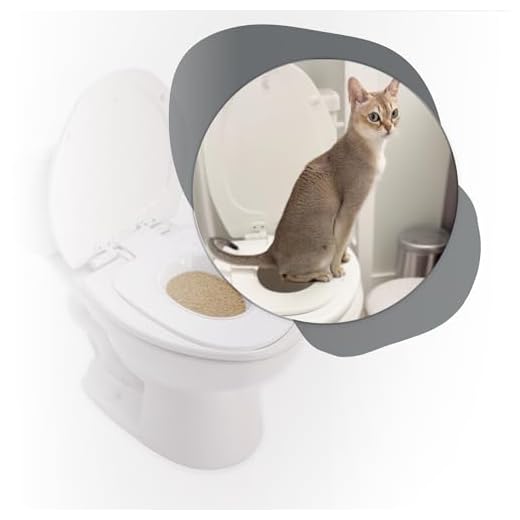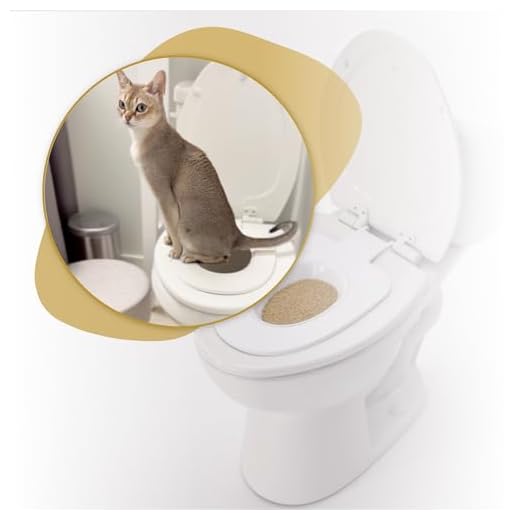



It typically takes between 2 to 6 weeks to help your furry companion adopt a new bathroom routine. Each kitty is unique, and factors like age, personality, and previous experiences can influence this timeframe.
To facilitate the process, start by introducing a litter box in a quiet, accessible area. Ensure the box is clean and use a litter type that your pet is comfortable with. Gradually, you can transition to a toilet training system designed specifically for cats, which simplifies the process.
Consistency is key. Regularly guide your pet to the designated area after meals and play sessions. Rewarding successful attempts with treats or praise creates a positive association with the new setup. Patience will pay off as your feline adjusts to this change in their routine.
Understanding the Typical Timeline for Cat Potty Training
Typically, the process spans from a few days to several weeks. Key factors influencing this timeframe include age, temperament, and prior experiences.
- Kittens: Young felines often adapt quickly, sometimes mastering the basics within a week.
- Adult Cats: Mature cats may require more time, particularly if they have established habits or phobias related to litter boxes.
- Consistency: Regularity in routines aids in faster adaptation. Reinforcing positive behaviors with treats can also speed things up.
- Environment: A calm, stress-free setting helps. Ensure the litter box is easily accessible and kept clean.
For those with neutered companions, it’s crucial to provide appropriate nutrition to support their health. Consider checking out food for neutered cats to ensure optimal well-being during this transition.
Remember, patience is vital. Each feline is unique, and some may progress faster than others. Observing their behavior will provide insights into their comfort level and readiness.
Factors influencing the duration of kitty training
Age plays a significant role in the speed of learning. Younger felines often adapt more quickly to new habits compared to older ones. Kittens, typically under six months, show greater curiosity and willingness to explore. Meanwhile, mature companions may require additional patience.
Temperament directly affects progress. An adventurous and playful spirit can make the process smoother. If your furry friend is timid or easily stressed, be prepared for a longer adjustment period. A calm environment can help ease the transition.
Consistency is key. Regular routines help establish new behaviors. Frequent reinforcement through praise and rewards accelerates understanding. On the contrary, inconsistent practices can confuse your kitty, leading to setbacks.
Environmental factors also matter. A clean, quiet space encourages your furry friend to feel comfortable. Distractions or loud noises can hinder focus, so consider setting up a designated area for this new practice.
Health influences readiness. Ensure your little one is in good health. Any underlying medical issues may affect their ability to adapt. A quick check-up at the vet can rule out any concerns that might prolong the process.
Lastly, the presence of other pets can impact the learning curve. A supportive companion may encourage faster adaptation, while a dominant pet might create anxiety, slowing progress. Observing interactions can provide insights into how to best support your furry friend’s journey.
Step-by-step guide for successful potty training
Begin with a litter box that resembles a regular toilet. I recommend a simple, shallow box without a lid to make the transition smoother.
Gradually elevate the box to mimic the height of a toilet seat. Use sturdy, stable materials to ensure safety and comfort. Adding a sturdy platform beneath the box can help during this phase.
Next, reduce the amount of litter in the box. Over time, decrease the litter level until it’s just a small amount. This helps adjust your pet to the idea of fewer materials.
Once your furry friend is comfortable with minimal litter, it’s time to introduce a training seat. There are various products available that fit over toilets, designed specifically for this purpose. Choose one that has multiple rings to gradually reduce the size, allowing for easy adjustment.
Encourage your companion to use the new setup by placing treats nearby. Positive reinforcement works wonders. Celebrate every small victory to keep their spirits high.
Monitor the process closely. If you notice any signs of stress or hesitation, take a step back and provide comfort. It’s okay to revisit the previous stages for a little while.
Consistency is key. Establish a routine for bathroom breaks to help your friend understand when it’s time to use the facilities. Regular intervals will reinforce the habit.
As your companion adapts, gradually phase out the training seat. Allow them to adjust to the toilet itself, ensuring they feel secure during this transition.
Patience is crucial. Celebrate progress, no matter how small, and remain supportive throughout the process. With dedication, success is within reach!
Common Challenges and How to Overcome Them
One big hurdle is resistance to the new setup. If I notice my human struggling, I suggest placing the litter box near the toilet initially. Gradually lifting it helps me adjust without panic.
Accidents on the Floor
Sometimes, accidents happen. If I see a mess, I recommend my human stay calm. Clean it up with an enzymatic cleaner to eliminate odors. Keeping my environment consistent is key; if changes occur, I might regress.
Loss of Interest
If I’m not showing enthusiasm, my human should check the toilet seat for comfort. Ensuring it’s stable and not too high makes a difference. Offering treats when I use the toilet can keep motivation high.
Another issue might be fear of the flushing sound. I suggest they practice flushing while I’m nearby, slowly getting me used to it. Positive reinforcement helps me feel safe in this new routine.
Patience is essential. Every feline learns at their own pace, and my human should celebrate small victories along the way. With consistent effort and understanding, the process can become smoother.
Signs that your cat is ready for potty training
As an 8-year-old Scottish Fold, I’ve noticed several key indicators that suggest a feline is prepared for a new bathroom routine. First, if your furry friend consistently uses their litter box without accidents, it shows they understand where to go. This behavior reflects their comfort with the concept of a designated bathroom area.
Another sign is curiosity about the human bathroom. If your kitty follows you to the restroom or shows interest in the toilet, they may be ready to transition. Additionally, age matters–most cats are best suited for this change between 4 months and 1 year. If your companion falls within this range, it could be a great time to start.
Behavioral cues
Pay attention to your cat’s body language. If they scratch or sniff around the bathroom, it indicates a desire to explore new options. Furthermore, if your cat has displayed signs of being more independent, like spending time alone or exploring new spaces, it might signal readiness for a different bathroom setup.
Lastly, ensure they are healthy. A visit to the vet is essential to rule out any medical issues that could affect their ability to adapt. Once you confirm their health, you can confidently begin this new chapter. For those who enjoy capturing their cat’s antics, consider investing in the best budget digital still camera to document the process!
When to Seek Professional Help for Training
If you’re struggling with my training process, it might be time to consult a specialist. Look for signs such as persistent accidents outside the litter box, refusal to use the designated area, or anxiety during the process. These behaviors can indicate deeper issues that need expert attention.
Key Indicators for Professional Assistance
| Sign | Recommended Action |
|---|---|
| Frequent accidents | Consult a veterinarian to rule out medical issues. |
| Avoidance of the litter box | Seek advice from an animal behaviorist to address stress or fear. |
| Extreme anxiety during sessions | Consider a professional trainer to create a calmer environment. |
| Inconsistent progress | Engage a specialist for tailored techniques and support. |
Addressing these challenges promptly can help ensure a smoother adjustment for everyone involved. Don’t hesitate to reach out for help if the process becomes overwhelming. It’s better to seek guidance than to struggle alone.
FAQ:
How long does it typically take to potty train a cat?
The time it takes to potty train a cat can vary significantly. On average, it may take anywhere from a few days to several weeks. Factors that influence this duration include the cat’s age, temperament, and prior habits. Younger cats often adapt more quickly than older ones. Consistency and patience from the owner also play a significant role in the process.
What are some common challenges I might face while potty training my cat?
One common challenge is the cat’s resistance to change. If a cat is accustomed to using a litter box, they may be hesitant to transition to a toilet. Additionally, some cats may be fearful of the noise associated with flushing or the instability of a toilet seat. It’s important to address these fears gradually, using positive reinforcement to encourage them. Distractions or changes in the cat’s environment can also affect their willingness to adapt.
Can all cats be potty trained, or are there certain breeds that are more receptive?
While most cats can be potty trained, some breeds are known to be more adaptable and receptive to this type of training. Breeds like Siamese, Burmese, and Bengal cats are often reported to be more trainable. However, individual personality plays a significant role as well. Each cat is unique, so it’s essential to pay attention to their behavior and adjust your training approach accordingly.








